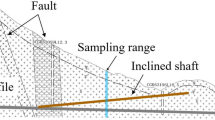Summary
Experimental evidence from true triaxial tests on dense rocks are analysed with emphasis on the failure modes of these materials under multiaxial loading, ambient temperature and external pressure. The strong dependence of the modes of fracture on the secondary components of applied stresses, and especially on the intermediate principal stress, indicated that the failure surface of these brittle materials may be appropriately described by a failure tensor polynomial criterion. As such, the elliptic paraboloid failure criterion was found to conveniently describe their mode of failure, by considering also the severe influence of anisotropy of the material.
For this purpose, a method developed recently (Theocaris and Panagiotopoulos, 1995a, 1995b) was applied, defining anisotropic hardening plasticity through an appropriate sequence of anisotropic elasticity problems. Assuming a particular path of loading or unloading, we measured the instantaneous tension and compression yield stresses along the transient principal-stress directions. These parameters completely define the instantaneous state of anisotropy of the body for the corresponding loading step, by applying the theory of the elliptic paraboloid failure locus (EPFS) (Theocaris, 1989a). A parameter identification problem was formulated on the constitutive expressions for this most general failure criterion. Then, by applying convenient constraints derived from the EPFS theory, which serve as filters throughout the whole procedure, the characteristic values of terms defining the variable components of the failure tensor polynomial were calculated, as the material was continuously loaded from the elastic into the plastic region and up to the ultimate failure load. Accurate simple tests in uniaxial tension and compression provided sufficient data for the definition of the yield loci of the material, at the considered loading step. These tests may be complemented with biaxial and triaxial modes of loading of the specimens. The results improve the accuracy and sensitivity of the method. All such data were used as input values, for establishing the mode of plastic deformation of the body during particular loading paths.
Moreover, the method employed allows the complete definition of the components of the failure, H, and the strength differential effect, h, tensors at each loading step. These quantities define completely the failure tensor polynomial for each material. Therefore, it presents the important advantage over other experimental methods by clearly indicating the parts contributed to the failure mode (either by plasticity, or by the strength differential effect) and their evolution during plastic deformation.
As convenient prototype materials for testing the method, specimens of metamorphic rocks such as Westerly granite (G), or quartzite (Q) were selected. Interesting results concerning the mechanical and especially the failure modes of such materials were obtained. Furthermore, the mechanical tests indicated clearly some basic properties of these materials as concerns the mode of their structure.
Similar content being viewed by others
Author information
Authors and Affiliations
Rights and permissions
About this article
Cite this article
Theocaris, P. Failure Loci of Some Igneous and Metamorphic Rocks. Rock Mech Rock Engng 32, 267–290 (1999). https://doi.org/10.1007/s006030050048
Issue Date:
DOI: https://doi.org/10.1007/s006030050048




